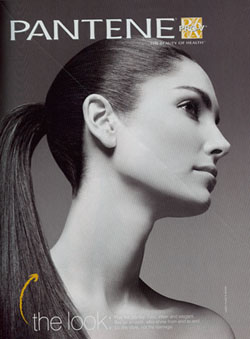Metaphors which connect women with domesticated animals perpetuate the derogation and objectification of women. In the article “The Semantic Derogation of Woman,” Muriel Schulz illustrates how over time, terms used to describe horses like jade, harridan, and tit have been used to refer to women, and have acquired sexual overtones when used in this way. Schulz states that using a vocabulary to describe women that is usually applied to horses carries the implication that women are ‘mounts’ (139-140). Contemporary evidence of the horse metaphor is found in Proctor and Gamble’s advertising for Pantene Pro-V hair products targeted to a female audience in the magazine In Style.
The dominant reading of this advertisement equates health and beauty. The hair product promises that it will work quickly and will make the user “sleek”. This product will be reliable: the user can ‘bet on’ it to do what it offers. This product will be effective and thorough: it will make the user “shine from end to end.” The product promises to do no damage, consequently it can be considered healthy for the body. This product will allow the user to ‘win’ the race for style. Using this product will make the consumer many things: sleek, elegant, smooth, silky, shiny, stylish, undamaged, and a winner.
 Play the ponies. Fast, sleek, and elegant.
Play the ponies. Fast, sleek, and elegant.
Bet on smooth, silky shine, from end to end.
Do the style, not the damage.There are many suppositions in this advertisement. The first is that women want to be healthy. Twice in this advertisement the product asks the reader to equate beauty and health (“the beauty of health” and “not the damage”). This advertisement also presupposes that women want to be beautiful and stylish. If a woman is not concerned with her appearance than this advertisement will be meaningless to her. The language “play the ponies” and “bet on” makes use of gambling metaphors and suggests that there is an element of chance in being well groomed. This advertisement suggests that products, specifically hair care products, are needed to make a woman attractive.
If this product promises to do no damage it presupposes that there are other products that are damaging. The reader is encouraged to avoid using a product that might harm her.
The use of the horse metaphor presumes prior knowledge of the characteristics of racehorses: ponies are fast, sleek, and elegant. This advertisement is suggesting that if a woman uses this product she will also be all of these things. There is a presupposition that the reader wants to be all of these things. It is presupposed that the reader has “ends” that she wants to be smooth, silky, and shiny. If the reader makes her ends smooth and shiny she will be stylish. Apparently the reader must currently be something other than fast, sleek, elegant, smooth, silky, shiny, and stylish.
In a negotiated reading of the Pantene advertisement a reader might see the references to horses inherent in the advertisement’s text but may not interpret it as a direct metaphor for women. She may feel that comparing a woman’s appearance to the power and majestic beauty of a racehorse is positive. Racehorses are admired for their long and shapely necks, their grace, their beauty, and their eyes. A woman might see this comparison as a compliment.
An alternative reading and the one that this course suggests is as Schulz proposes. The use of the horse metaphor is derogative to women. The image used in the advertisement presents the model’s head so she resembles a racehorse. Her neck is stretched and turned away from the camera to increase the appearance of its length; her hair is pulled back tightly in (ironically) a ‘ponytail’ to look like the mane and tail of a horse. The photograph is done in black and white to remove the skin tones that would distract from comparison between the model’s head and a horse’s head. This advertisement objectifies the model making only one part of her body (her hair) visible, that is, significant.
Horseracing is a tradition historically engaged in by the aristocracy and elite. A healthy horse requires a great deal of costly care: grooming, exercise, healthy diet, and healthy environment. A healthy horse is often considered a great beauty: something to prize. Equating women with horses suggest that they too are something to own, something to prize, something to groom. Racehorses have only a finite usefulness. Injury and age decrease their value and in time they become only pasture ornaments. This is also contemporary Western society’s opinion of women: youth and ability are of high value in the capitalist economy but women who are neither young nor productive can try to exploit society’s obsession with female appearance.
In the context of this advertisement and the language of horseracing it is implied that some ponies are winners and some ponies are losers. This can be extrapolated to women: some are winners and some are losers. In contemporary society the concept of ‘winning’ is valued. There is an element of chance and luck, and a prize at the end, the same that provides the addictive adrenalin rush craved by gambling addicts. It is considered common knowledge that everyone wants to be a winner and this is what Proctor and Gamble promises to the user of this product. The alternative reading suggests that women are a prize that can be won.
Works Cited
Schulz, Muriel R. “The Semantic Derogation of Women.” The Feminist Critique of Language, 1st edition. Ed. Deborah Cameron. London and New York: Routledge. 1990. 139-140.
 Comments(0)
Comments(0)